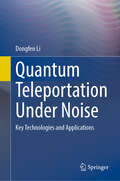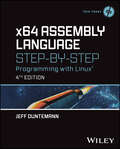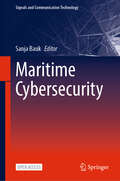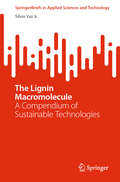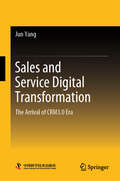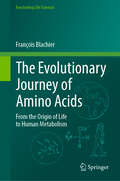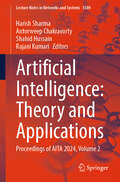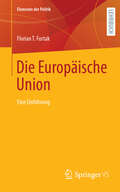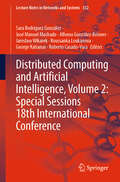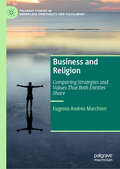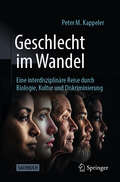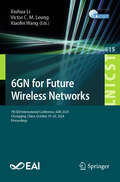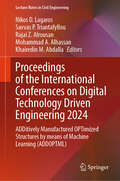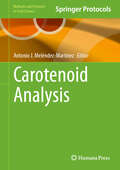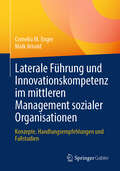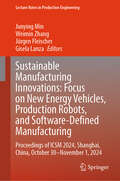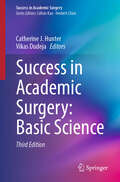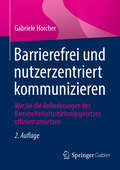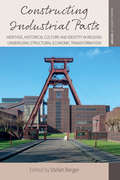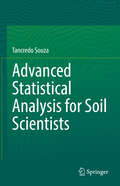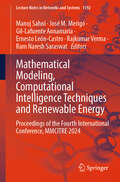- Table View
- List View
Quantum Teleportation Under Noise: Key Technologies and Applications
by Dongfen LiThis book offers a deep dive into quantum teleportation and immune noise models, providing cutting-edge solutions to challenges in noisy quantum communication systems. It covers advanced theories and practical methods for building robust, high-fidelity quantum channels that ensure secure communication even in noisy environments, making it a vital resource for researchers and professionals in quantum information science. Key topics include quantum teleportation protocols, immune noise models, quantum information splitting, and multi-degree-of-freedom quantum teleportation. By developing a unified framework for high-fidelity quantum channels, the book tackles major issues like "entanglement death," decoherence, and channel capacity limitations. It offers solutions to improve quantum state fidelity, channel performance, and security, enhancing the practicality of quantum teleportation in areas like national defense, finance, and secure communication. The book targets academic researchers, engineers, and professionals in quantum information, cryptography, and secure communications, along with advanced students interested in quantum teleportation in noisy environments.
x64 Assembly Language Step-by-Step: Programming with Linux (Tech Today)
by Jeff DuntemannThe long-awaited x64 edition of the bestselling introduction to Intel assembly language In the newly revised fourth edition of x64 Assembly Language Step-by-Step: Programming with Linux, author Jeff Duntemann delivers an extensively rewritten introduction to assembly language with a strong focus on 64-bit long-mode Linux assembler. The book offers a lighthearted, robust, and accessible approach to a challenging technical discipline, giving you a step-by-step path to learning assembly code that’s engaging and easy to read. x64 Assembly Language Step-by-Step makes quick work of programmable computing basics, the concepts of binary and hexadecimal number systems, the Intel x86/x64 computer architecture, and the process of Linux software development to dive deep into the x64 instruction set, memory addressing, procedures, macros, and interface to the C-language code libraries on which Linux is built. You’ll also find: A set of free and open-source development and debugging tools you can download and put to use immediately Numerous examples woven throughout the book to illustrate the practical implementation of the ideas discussed within Practical tips on software design, coding, testing, and debuggingA one-stop resource for aspiring and practicing Intel assembly programmers, the latest edition of this celebrated text provides readers with an authoritative tutorial approach to x64 technology that’s ideal for self-paced instruction.
Maritime Cybersecurity (Signals and Communication Technology)
by Sanja BaukThis book highlights the importance of cybersecurity in the maritime domain, including the human and societal aspects of both cyber-crime and cyber-defense. The authors present mechanisms for early detection and prevention of cyber-attacks, as well as security protocols based on testbed nautical simulator experiments, machine learning algorithms and artificial intelligence applications. This collection of research articles addresses the ethical, societal and technical aspects of maritime cybersecurity and offers solutions to mitigate the threat of cyber-attacks. The book is designed to help both researchers and stakeholders across the maritime ecosystem, including shipping and port logistics. Research findings are presented in the following areas: human factors in maritime cyber security, cyber security awareness and skills of seafarers, vulnerabilities in electronic maritime navigation on manned and unmanned vessels, internal and external attack vectors on bridge and propulsion systems, cyber security threats and countermeasures in seaports. The book serves as a handbook for those professionally involved in or interested in cybersecurity of IT and OT systems. This book is open access, which means that you have free and unlimited access.
The Lignin Macromolecule: A Compendium of Sustainable Technologies (SpringerBriefs in Applied Sciences and Technology)
by Silvio Vaz Jr.This book covers lignin, a renewable source of carbonaceous material derived from biomass, which is a subject of research, development and innovation in both academia and industry. From lignin we can obtain chemicals (e.g., aromatics, phenols), materials (e.g., fibres, engineered plastics, modified polymers), specialties (e.g., additives as antioxidant), among other products in diverse levels of technology readiness. However, there are challenges to overcome in terms of chemical structure, industrial yields of conversion processes, and the quality of raw material in order to reach the best uses and applications according to the sustainability vision for products and processes. This book deals with the main biochemical pathways of synthesis; advanced analytical techniques; extraction strategies; chemical, biochemical, biological, and physical processing for chemicals and materials; circularity and sustainability aspects for actual and future production chains, allied to life cycle assessment and industrial ecology.
Optimization Problems in Radiotherapy for Hypoxic Tumors (Biological and Medical Physics, Biomedical Engineering)
by Alexei V. ChvetsovThis book highlights the mathematical aspects of treatment outcomes analysis and dose optimization in radiotherapy for heterogeneous hypoxic tumors. Hypoxia is a major factor of cancer resistance to radiotherapy treatment and is present in most tumors encountered in humans. The author tried to present a systematic consideration of radiotherapy for hypoxic tumors, but the emphasis was put on mathematical content of the problems. The book contains new approaches to the concepts of tumor control probability, equivalent uniform dose and radiotherapy dose optimization for hypoxic tumors developed by the author. Significant attention in this book is paid to comparison of models with measured and clinical data; therefore, the reduction of model parameters to overcome overfitting (model parsimony) was followed as much as possible.
Sales and Service Digital Transformation: The Arrival of CRM3.0 Era
by Jun YangThis book provides a systematic and comprehensive introduction to CRM3.0 in the digital era, which includes innovation in sales and service theoretical systems, in digital tools and products, in value evaluation systems, and in support systems, combined with cases of enterprises. It elaborates on sales in the digital era from different perspectives such as theoretical systems, business models, value output, and digital tools, as well as how to serve digital innovation and transformation. This book involves lots of charts, combined with cases of industry innovation and transformation of typical enterprises, to provide reference and inspiration for managers and practitioners in business especially who are in demand of digital transformation for enterprises, as well as the readers in business schools.
The Evolutionary Journey of Amino Acids: From the Origin of Life to Human Metabolism (Fascinating Life Sciences)
by François BlachierThis book takes readers on a journey from the very fundamental and chemical beginnings of amino acids on Earth to their role in human metabolism. It provides background on how amino acid metabolism has changed across the evolutionary tree and discusses their physico-chemical properties as well as their biochemical roles across various forms of life. Amino acids are emerging as key players in numerous physiological functions and are being increasingly recognized as playing a mechanistic role for the communication between the gut microbiota and the host in healthy state and in some pathophysiological situations. However, understanding these associations requires a multidisciplinary approach, combining chemistry, biochemistry, physiology, nutrition, molecular/cellular biology and microbiology. This book aims to describe the science behind amino acids from their first appearance and evolutionary significance, all the way through the tree of life to humans, and then to consider how gut microbial amino acid metabolism regulates human physiology and risk in some chronic diseases. It covers key concepts such as the characteristics of different amino acids found in living organisms, their existence in the pre-living world, and their vital roles in metabolism and physiology. It also explores intriguing questions about microbial communication and the effect of amino acid-derived microbial metabolites on mammalian cells. With this multidisciplinary approach and accessible structure, this book will appeal not only to students and researchers with a background in biochemistry and related fields, but also to non-specialists with an interest in the foundations of life at the intersection of evolutionary biology and metabolism.
Artificial Intelligence: Proceedings of AITA 2024, Volume 2 (Lecture Notes in Networks and Systems #5589)
by Shahid Hussain Harish Sharma Antorweep Chakravorty Rajani KumariThis book features a collection of high-quality research papers presented at International Conference on Artificial Intelligence: Theory and Applications (AITA 2024), held during 9–10 August 2024 in Bengaluru, India. The book is divided into two volumes and presents original research and review papers related to artificial intelligence and its applications in various domains including health care, finance, transportation, education, and many more.
Die Europäische Union: Eine Einführung (Elemente der Politik)
by Florian T. FurtakDieses Lehrbuch bietet eine ideale Einführung in die Europäische Union (EU). Es präsentiert die EU auf kompakte und verständliche Weise und verschafft ein grundlegendes Verständnis des Staatenverbundes, der das Leben von rund 450 Millionen Bürgerinnen und Bürgern maßgeblich beeinflusst. Der Band richtet sich an Studierende und Lehrende der Politikwissenschaft sowie verwandter Disziplinen und zielt darauf ab, fundierte Kenntnisse über die politischen und rechtlichen Prozesse innerhalb der EU zu vermitteln und diese zu vertiefen. Um den Lesern die Orientierung zu erleichtern und wichtige Informationen hervorzuheben, verwendet das Lehrbuch verschiedene didaktische Elemente.
Distributed Computing and Artificial Intelligence, Volume 2: Special Sessions 18th International Conference (Lecture Notes in Networks and Systems #332)
by Alfonso González-Briones Roussanka Loukanova Roberto Casado-Vara Sara Rodríguez González George Katranas José Manuel Machado Jaroslaw WikarekThis book highlights the latest research on distributed computing and artificial intelligence. DCAI 2021 is a forum to present applications of innovative techniques for studying and solving complex problems in artificial intelligence and computing areas. The present edition brings together past experience, current work and promising future trends associated with distributed computing, artificial intelligence and their application in order to provide efficient solutions to real problems. This year’s technical program will present both high quality and diversity, with contributions in well-established and evolving areas of research. Specifically, 55 papers were submitted to main track and special sessions, by authors from 24 different countries representing a truly “wide area network” of research activity. Moreover, DCAI 2021 Special Sessions have been a very useful tool in order to complement the regular program with new or emerging topics of particular interest to the participating community. The technical program of the Special Sessions of DCAI 2021 has selected 23 papers. We would like to thank all the contributing authors, the members of the Program Committees, the sponsors (IBM, Armundia Group, EurAI, AEPIA, APPIA, CINI, OIT, UGR, HU, SCU, USAL, AIR Institute and UNIVAQ) and the Organizing Committee of the University of Salamanca for their hard and highly valuable work.
Business and Religion: Comparing Strategies and Values That Both Entities Share (Palgrave Studies in Workplace Spirituality and Fulfillment)
by Eugenio Andrés MarchioriThis book explores the connections between Christian religions and businesses. It examines how companies adopt tools traditionally used by churches to manage culture, strategy, and values while also exploring how churches leverage business strategies to achieve similar objectives. The author analyzes the mechanisms of influence both institutions use to internalize the "soul" of their organizations, including marketing systems, supported by real-world case studies. Later, he shows how companies like Coca-Cola behave like secular religions. He then compares how religious organizations—such as the Catholic Church, the Willow Creek Community Church, and the Jesuit Order—employ influence and business strategies similar to those of corporations like McDonald's, Mary Kay, and the consulting firm McKinsey & Co. By examining these parallels, this work reveals that business corporations and churches operate in fundamentally similar ways. Lastly, this volume estimates the monetary dimensions of what the author refers to as the &“salvation market.&” As society has become more demanding of corporate behavior, companies have responded by developing new areas—such as human resources to improve employee conditions, marketing to attract customers and talent, and the concept of stakeholders, which gave rise to a focus on ethical considerations, such as corporate social responsibility (CSR) as well as diversity and inclusion initiatives. The culmination of this process today is a strong emphasis on sustainability, showing how these new ethical values have gained prominence. Exploring organizational dynamics through a sociological lens, this book will appeal to researchers interested in organizational behavior, strategy, and marketing who seek to learn about the cultural dynamics of business and religious organizations.
Geschlecht im Wandel: Eine interdisziplinäre Reise durch Biologie, Kultur und Diskriminierung
by Peter M. KappelerWarum spielen Geschlecht und Gender eine so durchdringende Rolle bei der Gestaltung unserer Gesellschaften? Diese interdisziplinäre Frage lässt sich mit Forschungsergebnissen aus Biologie, Evolution und Anthropologie beantworten. Vor allem Frauen sind die zahlenmäßig größte Gruppe von Menschen, die aufgrund eines einzigen Merkmals in allen heutigen Gesellschaften diskriminiert und unterdrückt werden. Menschen mit nicht-binärem Geschlecht und nicht-heterosexueller sexueller Orientierung (LGBTQIA+) machen weltweit ähnliche Erfahrungen, die von sozialer Ächtung bis zur Androhung der Todesstrafe reichen. Gibt es biologische oder kulturelle Erklärungen für diese Opfer- und Täterrollen, warum und wie variieren sie über Kulturen und Zeiten hinweg, und welche Möglichkeiten für Veränderungen können aus dem Verständnis dieser Faktoren gewonnen werden? Um mit der Beantwortung dieser Fragen beginnen zu können, ist es wichtig zu verstehen, ob, in welchen Merkmalen und warum sich Frauen und Männer unterscheiden. Es gibt jedoch kein deutschsprachiges Buch, in dem diese Themen und Zusammenhänge differenziert, allgemein verständlich und ohne ideologische Vorgaben dargestellt werden. Dieses wissenschaftlich fundierte Sachbuch kann daher den notwendigen gesellschaftlichen Dialog zum Thema Sexismus konstruktiv unterstützen. Letztlich geht es in diesem Buch darum, zu verstehen, wie sich die Geschlechter in zahlreichen Anpassungen von der Befruchtung bis zum Tod unterscheiden, warum das Geschlecht eines Menschen eine so überragende Rolle bei der Strukturierung unseres Verhaltens spielt und warum dieses eine Merkmal letztlich auch wesentliche Aspekte unserer Kulturen und Gesellschaften prägt.
6GN for Future Wireless Networks: 7th EAI International Conference, 6GN 2024, Chongqing, China, October 19–20, 2024, Proceedings (Lecture Notes of the Institute for Computer Sciences, Social Informatics and Telecommunications Engineering #615)
by Victor C. M. Leung Xiaofei Wang Xiuhua LiThis volume set constitutes the proceedings of the 7th EAI International Conference on 6GN for Future Wireless Networks, 6GN 2024, held in Chongqing, China, in October 19-20, 2024. The 18 papers included in these proceedings were carefully reviewed and selected from50 submissions.They focus on the following topical sections such as Wireless Control and Network Optimization; Edge Computing and Resource Allocation; Intelligent Systems and Simulation; Artificial Intelligence and Digital Economy.
Proceedings of the International Conferences on Digital Technology Driven Engineering 2024: ADDitively Manufactured OPTimized Structures by means of Machine Learning (ADDOPTML) (Lecture Notes in Civil Engineering #646)
by Nikos D. Lagaros Khairedin M. Abdalla Savvas P. Triantafyllou Rajai Z. Alrousan Mohammad A. AlhassanThis book gathers the latest advances, innovations, and applications in the field of engineering optimization and architectural design, presented at the 1st International Conference on ADDitively Manufactured OPTimized Structures by means of Machine Learning (ADDOPTML), held in Amman, Jordan, on October 1–4, 2024, jointly with conferences OPTARCH2024 and OPT-ii2024. It covers topics such as machine learning-based design manufacturing process for civil structures, additive manufacturing optimized structural elements, holistic machine learning aided, linear, nonlinear, stochastic, parametric, discrete and dynamic programming—modelling, hybrid methods with metaheuristics, machine learning, game theory, mathematical programming, constraint programming, co-evolutionary, emergent nature-inspired algorithms such as quantum computing and artificial immune systems. Written by leading researchers and engineers, and selected by means of a rigorous international peer-review process, the contributions highlight numerous exciting ideas that will spur novel research directions and foster multidisciplinary collaborations.
Carotenoid Analysis (Methods and Protocols in Food Science)
by Antonio J. Meléndez-MartínezThis volume provides a summary on caroteniod handling and analysis, as this knowledge is essential and cannot be neglected. Chapter guide readers through methods on carotenoid analysis in different food and human matrices. Written in the format of the Methods and Protocols in Food Science series, chapters list necessary materials and methods for readily reproducible protocols. Authoritative and cutting-edge, Carotenoid Analysis aims to be comprehensive guide for researchers in the field.
Laterale Führung und Innovationskompetenz im mittleren Management sozialer Organisationen: Konzepte, Handlungsempfehlungen und Fallstudien
by Maik Arnold Cornelia M. EngerIn einer Zeit, in der soziale Dienstleistungsorganisationen vor immer komplexeren Herausforderungen stehen, wird die Fähigkeit zur Innovation und transformativen Führung zu einem entscheidenden Erfolgsfaktor. Das Buch widmet sich der zentralen Frage, welche Rolle die Laterale Führung im Kontext der Sozialen Arbeit und des Sozialmanagements spielt. Es führt nicht nur in die theoretischen Grundlagen dieses Führungskonzepts ein, sondern vermittelt auch praxisnahe Handlungsempfehlungen, um Führungskräfte im mittleren Management dabei zu unterstützen, innovative Ansätze zu entwickeln und umzusetzen. Beleuchtet werden im ersten Teil des Buches neben den Grundlagen Lateraler Führung insbesondere die innovationsorientierte Handlungskompetenz von Fach- und Führungskräften in der Sozialen Arbeit bzw. im Sozialmanagement. Der zweite Teil widmet sich der praktischen Anwendung der erarbeiteten Konzepte durch vier Fallstudien aus den Bereichen externe Mitarbeiter(sozial)beratung, Geflüchteten-/Migrationssozialarbeit, klinische Sozialarbeit und Offene Kinder- und Jugendarbeit. Diese realen Beispiele aus der Praxis der Sozialen Arbeit verdeutlichen, wie Laterale Führung und Innovationsmanagement in unterschiedlichen Kontexten erfolgreich umgesetzt werden können. Die Fallstudien bieten nicht nur eine Analyse der Herausforderungen, sondern auch Lösungshinweise und Fragen zur Reflexion, die die Leserinnen und Leser anregen sollen, eigene Erfahrungen und Ansätze zu hinterfragen. Dieses Buch richtet sich an Fachkräfte, Studierende und Interessierte im Bereich der Sozialen Arbeit und des Sozialmanagements, die sich mit den Herausforderungen und Chancen der Lateralen Führung und Innovation auseinandersetzen möchten. Es dient als Leitfaden für die Entwicklung und Erweiterung der eigenen Handlungskompetenz sowie für die Förderung einer individuellen und organisationalen Innovationsfähigkeit in sozialen Dienstleistungsorganisationen.
Sustainable Manufacturing Innovations: Proceedings of ICSM 2024, Shanghai, China, October 30-November 1, 2024 (Lecture Notes in Production Engineering)
by Jürgen Fleischer Gisela Lanza Weimin Zhang Junying MinThis book provides an in-depth exploration of the latest advancements in sustainable manufacturing, as presented at the International Conference on Sustainable Manufacturing. The proceedings focus on three pivotal areas: the production of new energy vehicles (NEVs), production robots, and software-defined manufacturing. The section on NEVs delves into innovations in battery technologies, lightweight materials, eco-friendly production processes, and sustainable sourcing, highlighting how these advancements reduce environmental impact and enhance efficiency. The segment on production robots examines the integration of automation and robotics to boost productivity and sustainability, emphasizing energy-efficient systems, collaborative robots (cobots), quality control, and predictive maintenance. The final part on software-defined manufacturing explores the digital transformation of manufacturing processes, discussing digital twins, the Industrial Internet of Things (IIoT), artificial intelligence, machine learning, cloud manufacturing, and cyber-physical systems. These technologies enable smarter, more adaptive, and sustainable manufacturing environments. This comprehensive collection of research and practical applications is essential for academics, industry professionals, and policymakers committed to advancing sustainable manufacturing practices.
Cell-based Immunotherapies for Cancer
by Alok K. Mishra Sunil K. MaloniaThis book explores the rapidly evolving field of cancer immunotherapy, which focuses on harnessing the immune system's power to combat cancer. As traditional treatments like chemotherapy and radiation therapy often have significant side effects and may not be effective for all cancer types, immunotherapy offers a promising alternative. Among the most notable advancements in this field are cell-based therapies, which involve modifying a patient&’s own immune cells or engineering specialized cells to enhance their ability to target cancer. Key approaches include chimeric antigen receptor (CAR) T-cell therapy, tumor-infiltrating lymphocyte (TIL) therapy, and dendritic cell (DC)-based therapy. Providing a comprehensive overview of these therapies, this book explores their scientific foundations, recent developments, clinical applications, and associated challenges. It also discusses emerging immunotherapeutic strategies, the commercial landscape, and future research directions. A valuable resource for researchers, clinicians, and industry professionals involved in cancer treatment, this book also serves as an informative reference for students and academics in biology, biotechnology, immunology, and related disciplines seeking a deeper understanding of cancer immunotherapy.
Success in Academic Surgery: Basic Science (Success in Academic Surgery)
by Catherine J. Hunter Vikas DudejaThis book advises the reader on the mechanics of starting a basic science research career as an academic surgeon. Written by established content experts, the chapters are both comprehensive and practical in their approach. The book includes a suggested timeline for the initial academic appointment, including how to setup and fund the laboratory and identifying appropriate scientific mentors and lab personnel. It also describes the application of basic and advanced research techniques, including animal models, flow cytometry, gene editing, tissue engineering, and microbiome analysis. Success in Academic Surgery: Basic Science is an essential guidebook for senior residents or fellows approaching their first academic appointment, young faculty in the process of establishing their research career, and more senior investigators interested in expanding their research horizons.
Barrierefrei und nutzerzentriert kommunizieren: Wie Sie die Anforderungen des Barrierefreiheitsstärkungsgesetzes effizient umsetzen
by Gabriele HorcherAb Juni 2025 verpflichtet das Barrierefreiheitsstärkungsgesetz (BFSG) erstmals auch Unternehmen zur digitalen Barrierefreiheit. Dieses Buch zeigt, wie Organisationen die gesetzlichen Anforderungen nicht nur erfüllen, sondern daraus echte Wettbewerbsvorteile entwickeln können. Kommunikationswissenschaftlerin Gabriele Horcher verbindet regulatorisches Know-how mit strategischem Weitblick und technologischer Innovationskraft. Mit praxisnahen Checklisten, Roadmaps, Branchenbeispielen und KI-gestützten Lösungen bietet das Buch konkrete Hilfestellung für Produkthersteller, Dienstleister, Händler und digitale Leistungserbringer. Es macht deutlich: Digitale Teilhabe ist kein Mehraufwand, sondern ein Zukunftsthema – für mehr Reichweite, bessere Kommunikation und nachhaltigen Unternehmenserfolg.
Artificial Intelligence Applications and Innovations. AIAI 2025 IFIP WG 12.5 International Workshops: MHDW 2025, ΑΙ4GD 2025, and SilverTech 2025, Limassol, Cyprus, June 26–29, 2025, Proceedings, Part II (IFIP Advances in Information and Communication Technology #754)
by Elias Pimenidis Harris Papadopoulos Antonios Papaleonidas Ioannis ChochliourosThis 2-volume set constitutes the refereed proceedings of International Workshops, held as parallel events of the 21st IFIP WG 12.5 International Conference on Artificial Intelligence Applications and Innovations, AIAI 2025, held in Limassol, Cyprus, during June 26–29, 2025. The 44 full papers and 6 short papers presented in these proceedings were carefully reviewed and selected from 117 submissions. The AIAI 2025 conference hosts several workshops that support innovative research on various specific and hot scientific domains every year. These satellite events offer a deep insight into both rapid advances and timely creative applications of AI.
Artificial Intelligence (Methods in Molecular Biology #2952)
by Sudip MandalThis volume focuses on how different artificial intelligence (AI) techniques like Artificial Neural Network, Support Vector Machine, Random Forest, k-means Clustering, Rough Set Theory, and Convolutional Neural Network models are used in areas of cell and genetic engineering. The chapters this book cover a variety of topics such as molecular modelling in drug discovery, design of precision medicine, protein structure prediction, and analysis using AI. Readers can also learn about AI-based biomolecular spectroscopy, cell culture-system, AI-based drug discovery, and next generation sequencing. The book also discusses the application of AI in analysis of genetic diseases such as finding genetic insights of oral and maxillofacial cancer, early screening and diagnosis of autism, and classification of breast cancer microarray data. Written in the highly successful Methods in Molecular Biology series format, chapters include introductions to their respective topics, lists of the necessary materials and reagents, step-by-step, readily reproducible laboratory protocols, and tips on troubleshooting and avoiding known pitfalls.Cutting-edge and thorough, Artificial Intelligence (AI) in Cell and Genetic Engineering is a valuable resource for readers in various research communities who want to learn more about the real-life application of artificial intelligence and machine learning in systems biology, biotechnology, bioinformatics, and health-informatics especially in the field of cell and genetic engineering.
Constructing Industrial Pasts: Heritage, Historical Culture and Identity in Regions Undergoing Structural Economic Transformation (Making Sense of History)
by Stefan BergerSince the 1960s, nations across the “developed world” have been profoundly shaped by deindustrialization. In regions in which previously dominant industries faced crises or have disappeared altogether, industrial heritage offers a fascinating window into the phenomenon’s cultural dimensions. As the contributions to this volume demonstrate, even as forms of industrial heritage provide anchors of identity for local populations, their meanings remain deeply contested, as both radical and conservative varieties of nostalgia intermingle with critical approaches and straightforward apologias for a past that was often full of pain, exploitation and struggle.
Advanced Statistical Analysis for Soil Scientists
by Tancredo SouzaIn the evolving field of soil science, advanced statistical analysis has become essential for understanding complex soil processes. Handbook of Advanced Statistical Analysis Applied offers a comprehensive guide to modern statistical methods such as PERMANOVA, ANOSIM, PCA, NMDS, RDA, and SEM, tailored specifically for soil science research.Through practical examples and case studies, the book demonstrates how these techniques can be applied to analyze complex datasets, identify patterns, and model interactions within soil ecosystems. It provides step-by-step guidance on data preparation, analysis, and interpretation, making it a valuable resource for students, early-career researchers, and professionals in soil science. By combining theoretical foundations with practical applications, Handbook of Advanced Statistical Analysis Applied presentes analytical tools needed to conduct rigorous research, contribute to scientific knowledge, and address challenges in sustainable land management. This book serves as a critical resource for mastering advanced statistical approaches in soil science.
Mathematical Modeling, Computational Intelligence Techniques and Renewable Energy: Proceedings of the Fourth International Conference, MMCITRE 2024 (Lecture Notes in Networks and Systems #1192)
by José M. Merigó Rajkumar Verma Ernesto León-Castro Manoj Sahni Gil-Lafuente Annamaria Ram Naresh SaraswatThe book is a collection of best-selected research papers presented at the Fourth International Conference on “Mathematical Modeling, Computational Intelligence Techniques and Renewable Energy (MMCITRE 2024),” organized by Department of Mathematics and Statistics, Manipal University Jaipur, Jaipur, Rajasthan, India. This book presents new knowledge and recent developments in all aspects of computational techniques, mathematical modeling, energy systems, applications of fuzzy sets and intelligent computing. The book provides innovative works of researchers, academicians and students in the area of interdisciplinary mathematics, statistics, computational intelligence and renewable energy.
